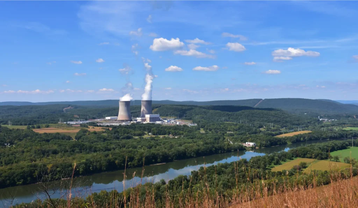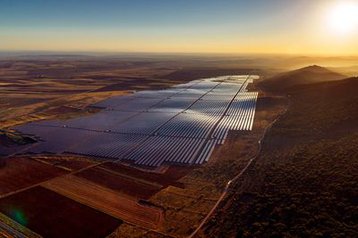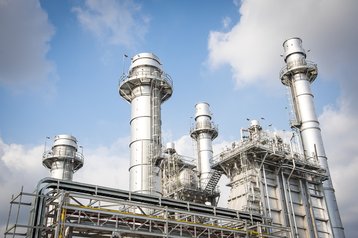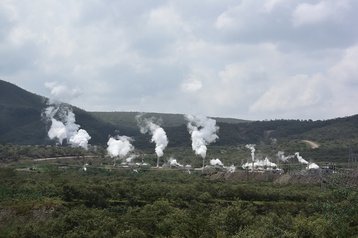For power procurement in the data center sector, 2024 was a landmark year. Energy demand from data centers has continued to rise, leading operators and the utilities that supply them to adopt an “all of the above” approach to quench their energy needs.
As a result, alternative power sources are growing in popularity, with nuclear, geothermal, and tidal energy systems signing contracts with data centers. In addition, there has been a renewed interest in fossil fuels for power operations in the short term, as fears over renewable energy’s ability to effectively serve the power needs of data centers have led many to look toward natural gas as an alternative in the short term.
Nuclear energy advances
Several hyperscalers took the plunge and signed long-term supply agreements with nuclear power operators for behind-the-meter supply during 2024.
In March, Amazon Web Services (AWS) acquired Talen Energy's 960MW Cumulus data center campus in Pennsylvania. The campus is powered by the adjacent 2.5GW Susquehanna Steam Electric Station.
The deal raised questions about the future of behind-the-meter deals within the sector. Following the agreement, regional grid operator PJM submitted an amendment to the proposed Interconnection Service Agreement (ISA) to increase the colocated load capacity from 300MW to 480MW. However, the Federal Energy Regulatory Commission (FERC) voted to reject the ISA, citing insufficient justification for the nonstandard provisions allowing a “unique” arrangement for the data center.
Talen has subsequently requested a rehearing, contending that since the data center is not connected to the broader grid, it would not cause cost-shifting and reliability issues. The ruling's implications will greatly impact future behind-the-meter agreements for data centers, especially within the nuclear sector, as we move into 2025.
However, the uncertainty has not discouraged other firms from exploring nuclear as a low-carbon option for their energy needs. In September, Microsoft signed a 20-year PPA with Constellation Energy to source 837MW from Pennsylvania’s Three Mile Island plant. Following this, Meta issued a request for proposals to identify developers to develop upwards of 1.4GW of new nuclear capacity.
Small modular reactors (SMRs) also gained traction, with Google, Equinix, and AWS all securing agreements with SMR developers to support projects across the US.
AWS made the most significant commitment by signing three separate deals across the sector. They included agreements with Energy Northwest that will enable the development of four advanced SMRs, Dominion Energy to explore the development of an SMR project near Dominion’s existing North Anna nuclear power station, and a direct investment in Gen IV SMR developer X-energy to support the construction of more than 5GW of new nuclear energy projects by 2039. The SMRs will, in turn, be deployed as part of AWS's deal with Energy Northwest.
The emergence of nuclear power was the most significant development in power procurement for the data center sector in 2024. However, concerns over the delivery timeline of SMRs (the technology is unlikely to be delivered until the 2030s at the earliest) and uncertainty about the traditional nuclear market's ability to deliver behind-the-meter power to data centers following the FERC ruling dampens confidence in the market of a real “nuclear” revolution within the sector.
Renewable procurement
The hyperscalers have also driven plenty of deals for renewable energy, mostly through Power Purchase Agreements (PPA).
A November report from S&P Global revealed that the US data center sector alone had contracted 50GW of clean energy by the end of Q3 2024. Solar dominated supply, with 29GW, followed by wind at 13GW. The growth in procurement is mirrored in the increase in renewable energy deployments in the US, with much of it in data hotspots like Virginia, Texas, and Oregon, where the impacts of the Inflation Reduction Act were most felt.
Data center operators have taken advantage of this significant growth, with several high-profile PPAs in the Texas market. The most notable of these came in May when Microsoft signed two 15-year PPAs with RWE to purchase 446MW from the Peyton Creek II and Lane City onshore wind projects.
The European renewable energy market was dominated by Amazon, Google, Microsoft, and Meta, with the quartet collectively procuring more than 12GW for their data centers. Spain emerged as Europe's largest market for data center PPAs, totaling 4.7GW, 60 percent of which was solar PV. Notable deals in Spain included Apple signing a 105MW solar power PPA with ib vogt, and Microsoft, inking a 230MW solar + wind PPA with Repsol.
The Spanish renewable market has been buoyed by recent legislation that has expedited the processing of environmental impact statements. This may inhibit further interest from data center operators seeking clean power agreements in the coming years.
Fossil fuel dilemma
Despite record levels of renewable energy procurement and the emergence of nuclear energy, US utilities are still scrambling for more power to meet skyrocketing demand. As a result, many have been exploring the deployment and extension of fossil fuels to power data center operations, despite the negative impact this has on the environment and combatting climate change.
In November, US gas and electric utility Southern Co. said it was considering extending the life of its four-unit, 3,450-MW Plant Bowen coal-fired facility in Georgia. In addition, coal power producer Hallador Energy signed a non-binding term sheet with an unnamed data center developer to supply it with energy for a prolonged period.
Some utilities have begun exploring the construction of natural gas plants to power major hyperscale data centers. Though this is less damaging than other fossil fuels, it still has a much higher carbon footprint than renewable power.
In December, Entergy agreed to power a 1 million sq ft (92,903 sqm) Meta data center by constructing three combined-cycle natural gas-powered combustion turbines with a combined capacity of 2,260MW. ExxonMobil followed this up by committing to build a 1.5GW natural gas plant dedicated to powering data centers.
S&P Global has subsequently projected that natural gas demand from data centers could reach up to three billion cubic feet per day (bcf/d) by 2030. Should natural gas assume a larger share, demand from data centers alone could climb as high as six bcf/d.
This has led some data centers to seek behind-the-meter agreements with natural gas providers in microgrid systems. These agreements allow them to avoid grid connection and transmission infrastructure issues that have stifled new power generation projects. Sharon AI recently expanded a behind-the-meter agreement with New Era Helium to power a 250MW data center in the Permian Basin.
Under the incoming US government, which is likely to be far more relaxed about the use of fossil fuels than its predecessor, these agreements will likely become more commonplace, with significant opportunities, especially in the North American market, due to its abundant natural gas.
Emerging technologies
Several power technologies also gained traction in the data center sector.
Geothermal saw a number of notable agreements. Like nuclear energy, geothermal is closely matched to data centers' power needs, providing consistent baseload power at a lower capacity than nuclear energy.
In May, Microsoft and G42 revealed plans for a data center in Kenya powered by the Olkaria geothermal plant in the country's southwest. The companies hope to begin operations in the next two years, with an expected initial capacity of 100MW. Geothermal is highly dependent on locale, which has led to enthusiasm in countries like Kenya, which has an abundance. As a result, Olkaria has become an emerging hub for data centers in Africa, with EcoCloud breaking ground on its own 'Project Eagle' geothermal-powered data center at the KenGen Green Energy Park in Olkaria last year.
Tidal energy has also recently emerged as a potential energy source for data centers. In November, Iron Mountain partnered with SeaQurrent to explore the provision of tidal energy to its AMS-1 data center in Amsterdam, starting in 2027.
The solution is deployed in farms, ranging from 500kW for a single system to hundreds of megawatts in size. The technology utilizes the natural rise and fall of tides to power underwater turbines, which deliver power to shore. Unlike solar and wind, which are more sporadic, tidal energy has more potential to be a baseload energy source, as tides are much more predictable.
News on the hydrogen front was limited compared to other years. However, the APAC region saw one major offtake agreement. In October, Keppel Data Centers signed a conditional offtake term sheet to purchase liquid hydrogen from Woodside to support its Singaporean portfolio.
While interest in emerging technology remains high, most of these projects remain in their pilot phase and are unlikely to disrupt traditional power sources' grip on the sector.
Transmission
Despite the abundance of deals within the power sector, there are major concerns that transmission and power generation infrastructure is lagging behind data center energy demand. These issues are exacerbated by the spatially concentrated nature of the data center market, with the sector surpassing 10 percent of electricity consumption in at least five US states and more than 20 percent in Ireland, according to the IEA.
A recent report from Virginia’s Joint Legislative Audit and Review Commission (JLARC) warned that if data center growth in Virginia continues under an unconstrained model, it will be “very difficult” to scale the power generation and transmission infrastructure needed to power them. The report projects that under an unconstrained model, average monthly energy consumption could reach more than 30,000GWh by 2040, far outstripping supply.
The US Department of Energy has announced billions of dollars in investment during 2024 to improve transmission infrastructure.
Commitments included the launch of ten transmission corridors across the country to accelerate the development of transmission projects in areas that present an urgent need for greater grid capacity. In addition, the DOE invested $1.5 billion in four projects across the southwest of the US and issued a Request for Proposals for the $1.2bn Transmission Facilitation Program, a bipartisan public-private project that aims to reshape the electric grid in America so it can support a shift to 100 percent clean energy.
As data center power demand increases, the need to upgrade the electrical grid, especially within the US, will become more and more crucial, requiring huge public and private investment.
Private utilities, including Xcel Energy and CPS Energy, have committed billions to transmission and grid upgrades this year. However, there are concerns that even with these capital commitments, more is required to effectively upscale the grid to meet the expected demand.
Read the orginal article: https://www.datacenterdynamics.com/en/analysis/diversity-of-power-the-biggest-data-center-energy-stories-of-2024/




